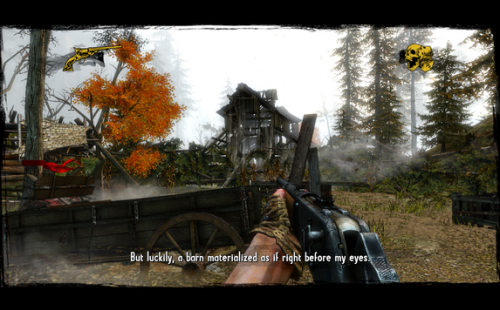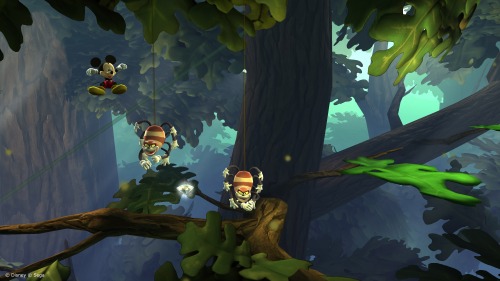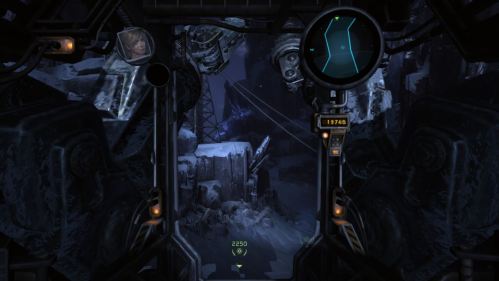Musings and Memories of 2013: Learning Humility
by Scott Nichols
Rather than a strict Game of the Year list, at Gamerly Musings I’ll be writing a series of articles about the games that were most important to me, personally. The games will be roughly grouped together by themes, qualities, or learning experiences that they shared rather than offering awards based on genre or release platform, which I think works out rather nicely for highlighting some under-appreciated games that would never appear on a “best of 2013” list but deserve special recognition in their own right.
The theme of this first post is “learning humility,” highlighting games that caught me off-guard or subverted my expectations in thrilling, surprising, and always humbling ways.
Call of Juarez: Gunslinger
It seems that every year I’m going to be asked to review a game for which I have rock bottom expectations and ends up being one of the highlights of the year. Last year it was I Am Alive, which blew me away with its brutal survival mechanics and story, and this year that pleasant surprise came in the form of Call of Juarez: Gunslinger (which, coincidentally, both I Am Alive and Gunslinger were published by Ubisoft).
I already wrote a glowing review when it came out, so I won’t retread through all the reasons it is such an amazing game here, but even now at the end of the year it sticks out in my mind as easily one of the best gaming experiences I had in 2013.
What I’d like to add to that review here, and why Call of Juarez: Gunslinger is one of the most important games for me personally beyond just being a good game, is how humbling it is. As much as I try not to, it’s almost impossible to go into a game for review without having some degree of expectations.
When my editor asked me if I’d be able to review Gunslinger, my first thought was actually to send out a ton of feature article pitches so that I’d be too busy and have an excuse to decline. Of course I wouldn’t actually do that, but the thought was there. Having never played the past Call of Juarez games, I’d only ever heard mediocre at best things about the first two games, and only universal loathing for The Cartel, so it wasn’t exactly a game I was eager to review.
But I took the assignment, and as the combos started counting and the level designs shifted around the tall tale storytelling of an unreliable narrator, I regretted every doubting it. I love that I can still be caught completely by surprise by a game, and it’s humbling to me as a critic for my expectations to be so far off base from how a game turns out.
Castle of Illusion Starring Mickey Mouse
Similar to how Call of Juarez: Gunslinger smashed my expectations, both Lost Planet 3 and Castle of Illusion Starring Mickey Mouse were far better than I could have guessed and deserve recognition. I’ll start with Castle of Illusion, a remake that oddly wouldn’t even use the original game’s level designs, negating its own nostalgia value. It was also being done by Sega, which hasn’t exactly been consistently on top of its game for many years when it comes to platformers. What the Castle of Illusion remake actually did though, was something spectacular.
Even though the levels were entirely new layouts, they were created in a way that perfectly captured the design sensibilities of the 16-bit era. Levels were packed with secrets requiring loosely informed leaps of faith and carefully bouncing on an enemy at just the right moment to reach a higher platform. Enemies would even respawn if you moved away from an area and came back, something that existed in older games due to memory limitations but was replicated here as a conscious design choice. And that the level layouts actually took advantage of the respawning enemies, like the example of bouncing on an enemy to reach a higher platform where you could purposefully keep spawning bats to try again if you miss the jump.
These are design sensibilities that were lost in the transition to 3D platformers, where most 3D platformers followed Mario 64‘s example of using replayable stages with multiple missions instead of the linear obstacle courses that dominated 2D platformers. Rayman 2 is the only 3D platformer from that era I can think of that managed to use linear levels while still incorporating ample exploration and secrets, with Rayman 3 taking more cues from the early Crash Bandicoot and Sonic Adventure games with levels that were more strictly linear. The Mario 64 model was so widely adopted because it fit 3D game spaces well, and in those early days of 3D games you either made everything 3D or didn’t make a game at all. The rare 2D platformers that were released at that time like Tomba squeezed out a sequel more by sheer force of will than due to significant sales demand.
The point of this history lesson is because to me Castle of Illusion felt like a game from a parallel universe where Mario 64 never happened (somewhat funny considering how closely the hub in Castle of Illusion resembles Mario 64’s) and 3D platformers took an entirely different evolutionary direction as a result. In this parallel universe there was a far more gradual shift from 2D to 3D platformers, allowing the 2D design sensibilities of 16-bit games to continue being used in 2D/3D hybrid games like Castle of Illusion (and Sonic games post-Sonic Colors).
And Castle of Illusion is really good, too, clever and challenging in all the right ways. As a platformer fan, it is tremendously exciting to play a game that feels like it sprang up out of such a different evolutionary thread from every game around it. It shows that there is still so much untapped potential in platformers that I can’t wait to see what’s next.
Lost Planet 3
Those who followed me on Twitter during 2013 are probably familiar with my less than glowing opinion of Spark Unlimited. Developer of such train wrecks as Legendary and Turning Point: Fall of Liberty, the studio’s continued existence while other more capable studios close up shop is to me one of the biggest mysteries of the gaming industry. So when Capcom announced that Spark Unlimited would be making Lost Planet 3, I set my expectations to the lowest they could possibly go. I mocked the game, openly, at any opportunity, and in any news articles about Lost Planet 3 I made sure to mention it was made by the same developers as Legendary and Turning Point: Fall of Liberty.
I can justify the news articles as wanting readers to be informed about the pedigree of who is making a particular game, but much of my conduct elsewhere was simply malicious and mean-spirited. I scheduled an interview with Spark Unlimited for E3 where I had interview questions lined up like “At what point after Turning Point: Fall of Liberty did you learn how to make a game?” and “How exactly did you get Capcom to trust you to develop Lost Planet 3?” I meant the questions in earnest, because based on demos Lost Planet 3 was by far their most playable game yet, but the wording and tone was out of line. Perhaps they were onto me and recognized my name from twitter, because Spark Unlimited stood me up for that interview, which their no-show just inspired more malicious comments on my part.
Fast forward to a month or two after Lost Planet 3‘s middling release, and I see Brad Gallaway tweeting about how much he loves the game. Now, Brad and I tend to have wildly different opinions about most games, to the point where we created the hashtag #oppositebros to commemorate our differences. But every once in a while there is a game we agree on, and those games tend to be magical stuff like Nier and I Am Alive, so if I see him recommending a critically panned game I take notice.
Lost Planet 3 won me over the second I got into the cockpit of Jim Payton’s rig. That’s an important distinction right there, that in Lost Planet 3 you’re piloting a rig, not a mech. This is a big, clumsy machine made for long mining trips rather than quick combat, and everything about the cockpit – from Jim’s memorabilia strewn about to the sort of frontier country music playlist – sells the idea that Jim is basically an 18-wheeler driver in space.
The messages sent back and forth between Jim and his wife on Earth, while their timing doesn’t always fit with the action at the time, further solidify his characterization with the sort of mundane yet genuine letters someone working abroad would send home to their family. And when Jim described the never-ending ice of EDN3 as “rightly cold” I just couldn’t help but smile at the subtly fantastic use of dialect that told me so much about Jim’s character in so few words.
Mundane is really the best word I can find to describe why Lost Planet 3 worked so well, with much of the enemy encounters in the game’s first half centered around fighting local wildlife while trying to set up a mining outpost, or repair a communications tower, or recover energy from a previously built mining outpost. And after every mission I’d return to the base, which felt a little more like home each time, and visited shops to see what new upgrades I could buy with my mission earnings that weren’t sent home to Jim’s family on Earth.
And it played well too. I mean, the third-person shooter sequences and occasional punch-out style rig fights weren’t anything spectacular, but they were well-executed for fairly generic mechanics, without ever distracting from that space trucker feel I loved so much. I even loved the semi-gated open world, through which I could upgrade my rig to gain access to new portions of the map and discover secrets in the areas I had already explored.
Lost Planet 3 was far from perfect. The story goes off the deep end in the second half, abandoning the mundane worker feeling for a less interesting plot about government conspiracies and corrupt corporations that feels obvious and disappointing after so much care had been put into the first half. The ending is also far too rushed, probably because the game had already seen too many delays and Capcom wasn’t inclined to extend development further. But even with the missteps in the second half, it’s not enough to undo all the good will Lost Planet 3 bought with its pitch perfect characterizations in the first half.
Lost Planet 3 proves that Spark Unlimited is not only capable of making a playable game, but a genuinely good one with a keen eye for storytelling. Perhaps it’s a studio that needs a bigger budget and longer development time than most to pull off their vision, which isn’t something to be proud of, but Lost Planet 3 at least proves that under the right conditions Spark Unlimited can deliver an impressive gaming experience.
This doesn’t mean I won’t still be critical of Spark Unlimited, the question of when they learned to make a game is more relevant than ever, but perhaps I need to put less stock in a studio’s history and more into each game on an individual basis. As one of the studio’s most vocal critics, I am humbled by just how well they pulled it off. So humbled, in fact, that I won’t even end this post with a cheap shot at Yaiba: Ninja Gaiden Z. I’ll let the trailers do that for me.
Oops.



I loved the space trucker feel of Lost Planet 3 but for whatever reason I had trouble on the PS3 version. Half the time the switch gun button just wouldn’t work. It didn’t matter if I was running, sprinting, or standing still. I couldn’t figure out if there was a rhyme or reason to it. So I ended up giving up even though I liked the “Truckers on Hoth” vibe.
Aw, that’s too bad because the interplay in switching between long/close range weapons or power/spread weapons is a pretty big part of the combat. I played it on PC (with an Xbox 360 controller) and the only bugs I ran into were some spots where the rig’s winch wouldn’t attach like it was supposed to, but a quit and restart usually fixed that. If you see it in a Steam sale for a particularly good price, it might be worth giving it another shot.